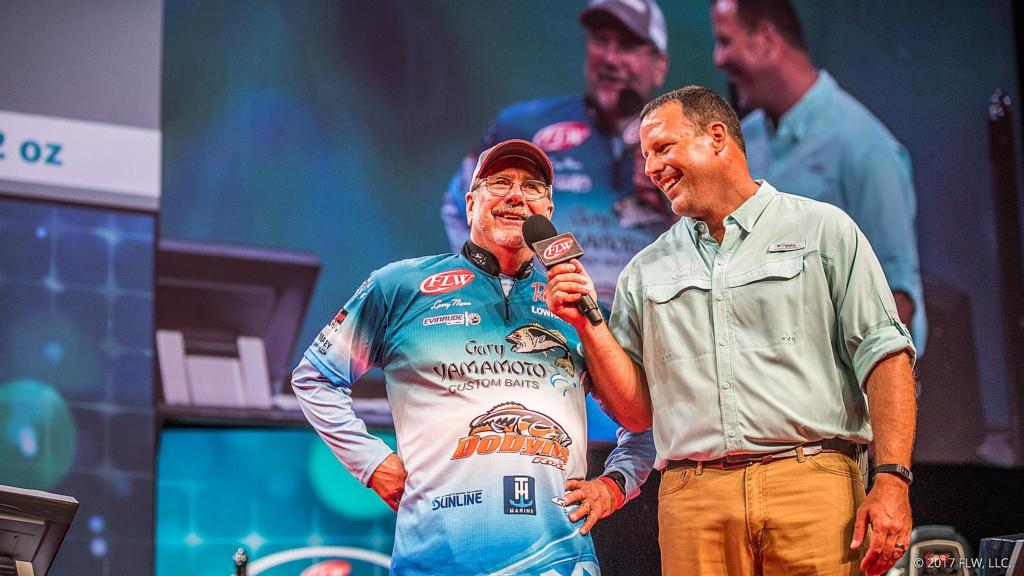Larry Nixon’s Run at the Cup
After a strong first day, the Arkansas pro failed to maintain pace and slipped out of the top 10

At one point Saturday morning during the Forrest Wood Cup, Larry Nixon and Brandon Cobb wound up fishing fairly close to each other. Both anglers were fishing for bass that were chasing blueback herring across the surface, but within a few casts, Cobb put down his rod and reel, pulled up his trolling motor, and quickly left for parts unknown. The daily herring bite was waiting somewhere else. An armada of a couple of dozen boats fell in behind the South Carolina pro, all sweeping away down the lake like leaves blowing along an October street.
When asked why he didn’t leave when Cobb vamoosed, Nixon exaggerated good-naturedly: “Because I don’t have anywhere else to go.” To be sure, he didn’t need to go anywhere else on the first day of the championship, as his five best bass gleaned from the same area the day before comprised the sixth best stringer at 17 pounds, 13 ounces. The second day, however, Nixon dropped to 17th in the standings, while Cobb moved into first. They were two anglers headed in opposite directions: Nixon with two fish that totaled 4 pounds, 5 ounces and Cobb with a culled limit of 19-4 that helped him eventually finish in third place.
What changed? For one thing, the wind, but only slightly, and the sunlight, dramatically. Where it was cloudy on opening day, the sun was out in the second round, and the schooling activity diminished considerably where Nixon was fishing. Boat traffic, fickle bass, the change in the barometric pressure, the slight drop in the water depth? Who knows – Nixon is still trying to figure it all out, but for now chalks it up to the vagaries of bluebacks and their predisposition to ad lib without a script to follow. Where they went, the bass followed.
“I had maybe five or six cane piles located and a long point in the main lake where I caught most of my fish both days. That was pretty much it,” says the Arkansas pro. “Lake Murray is a very good lake, but typically in August the weights aren’t going to be that big. That’s what just blew me away. I didn’t figure on the herring bite being so good and how many fish were on those dadgum cane piles. I just wish I had caught them the second day like I did the first.”
It’s no secret that Nixon considers a Forrest Wood Cup championship to be the exclamation point to his long and storied career. It’s the one jewel missing from a crown of accomplishments, and he wants it badly. It’s also safe to say that most fishing fans want it badly for the popular pro before age (he’s 66) and various physical ailments overtake him.
Next year, the tournament will take place on Lake Ouachita, not all that far from Nixon’s home in north central Arkansas, and close enough to grant him automatic status as a favorite. Ouachita suits his style of fishing, and Nixon is on a first-name basis with the bass there, figuratively speaking.
Lake Murray was mainly a wait-and-cast sort of place for Nixon. It quickly became apparent in the opening round that to catch fish an angler had to have a target, either a cane pile or a bass chasing bluebacks across the top.
The herring Nixon’s bass spit up in his livewell on opening day were as long as 8 inches, so he chose a big Heddon One Knocker Spook and a 6-inch Ever Green Shower Blows 150 pencil popper to match. Accuracy and distance were critical for the surface-feeding fish. Nixon used the lures he did because neither plug would sail or spin. Weighted in the tail, they threw in a straight line and landed where Nixon wanted them to.
“That very first day, after I caught the big stringer fairly early, I tried calling them up at my places just to see. I never called up one single bass – just stripers,” recalls Nixon. “That told me my odds were better waiting until they blew up before casting. But when those sons-of-guns came up, if you put a lure right in front of them, usually they would nail it.”
Usually, but not always, as the 2014 Cup champion on Lake Murray, Anthony Gagliardi, demonstrated. He stopped briefly several dozen yards away from Nixon’s boat to try his luck. Nixon could see fish busting all around him, and Gagliardi kept casting at them without success. Finally, frustrated, he left. There was nothing else to do but make the rounds and hope that somewhere the fish were more aggressive and less discriminating.
Nixon, too, soldiered on that last day on Lake Murray. By late morning, sunshine and heat were beginning to pester him. It made the wait for the sporadic surface action seem longer, but in truth there was not much to wait for. Overhead, several ospreys glided in random circles over the lake, borne by the thermals. Occasionally one would begin a dive toward an unseen fish, but then would abort and regain altitude.
Even the raptors got tired of waiting. Gradually they drifted off in their wide, searching gyres toward other hunting grounds, until they were fading specks of brown on blue.


